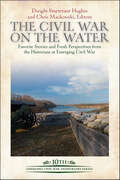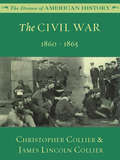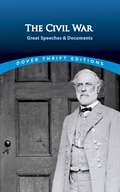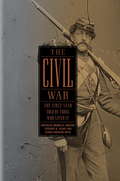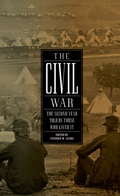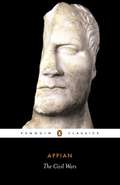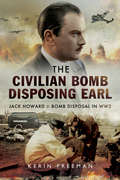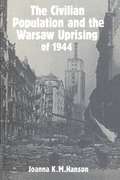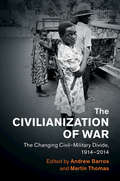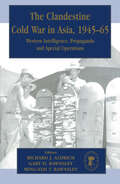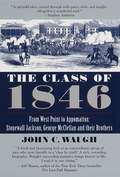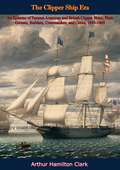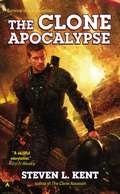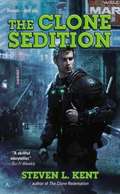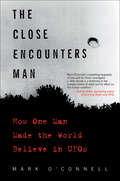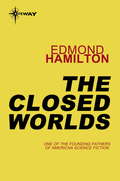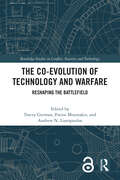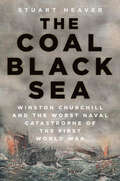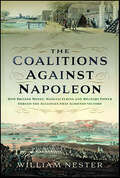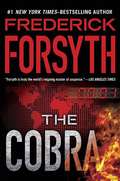- Table View
- List View
The Civil War on the Water: Favorite Stories and Fresh Perspectives from the Historians at Emerging Civil War (Emerging Civil War Series)
by Dwight Sturtevant Hughes And Chris MackowskiThe Civil War was primarily a land conflict, but it was not only that. “Nor must Uncle Sam’s web-feet be forgotten,” wrote Abraham Lincoln. “At all the watery margins they have been present. Not only on the deep sea, the broad bay, and the rapid river, but also up the narrow, muddy bayou, and wherever the ground was a little damp, they have been and made their tracks.” From the Arctic Circle to the Caribbean, swift Rebel raiders decimated Union commerce pursued by the U. S. Navy. Offshore, storm-tossed blockaders in hundreds of vessels patrolled from Hatteras to Galveston while occasionally lobbing a few shots at a speeding Rebel runner. Around the continental periphery, it was ships vs. powerful fortifications as titanic clashes erupted: Port Royal, New Orleans, Charleston, Mobile. Massive army-navy amphibious operations presaged twentieth-century conflicts: The Peninsula, North Carolina Sounds, Fort Fisher. In the heartland, the two services invented riverine warfare: Forts Henry and Donelson, Island No. 10, Memphis, Vicksburg. And through it all, emerging technology of the machine age played a critical role: iron armor, torpedoes, steam propulsion, heavy naval artillery. However, nothing in the history and traditions of the United States Navy had prepared it for civil war. The sea service would expand tenfold from a third-rate force to (temporarily) one of the most powerful and advanced navies. Meanwhile, former shipmates in the Confederacy struggled to construct a fleet from nothing, applying innovative technologies and underdog strategies to achieve more than anyone thought possible. Both sides faced unprecedented strategic, tactical, and technological challenges that made their navies indispensable—even as the navies themselves faced those same sorts of challenges. The Civil War on the Water: Favorite Stories and Fresh Perspectives from the Historians at Emerging Civil War compiles favorite navy tales and obscure narratives by distinguished public historians of the Emerging Civil War in celebration of the organization’s tenth anniversary. This eclectic collection presents new stories and familiar battles from a unique perspective—from the water—sea, surf, and stream.
The Civil War: 1860 - 1865
by James Lincoln Collier Christopher CollierHistory is dramatic -- and the renowned, award-winning authors Christopher Collier and James Lincoln Collier demonstrate this in a compelling series aimed at young readers. Covering American history from the founding of Jamestown through present day, these volumes explore far beyond the dates and events of a historical chronicle to present a moving illumination of the ideas, opinions, attitudes and tribulations that led to the birth of this great nation. The Civil War examines the people and events involved in the bloody war that pitted the Northern states against those that seceded to form the Confederacy. This book recounts events leading up to the war as well as to the battles themselves. The authors examine the lives & personalities of key figures, including Abraham Lincoln, Jefferson Davis, Ulysses S. Grant, and Robert E. Lee. The text is enhanced with images of art & artifacts, maps, and photographs from the era.
The Civil War: Great Speeches and Documents (Dover Thrift Editions: American History Ser.)
by Bob BlaisdellMemorable speeches, moving letters, and key reports are among the vital documents in this collection of historic records from the American Civil War. Even the most dedicated history buffs may find something new in this compendium, which ranges from familiar items such as the Gettysburg Address to private reflections that include Stonewall Jackson's message to his wife after the Battle of First Manassas and excerpts from the diary of a Confederate soldier at the siege of Vicksburg.Other highlights include "The War and How to End It," a lecture by Frederick Douglass; Robert E. Lee's farewell to the Army of Northern Virginia; and an eyewitness account of the clash between the Monitor and Merrimack. Selections by commanding officers from both sides of the Mason-Dixon line include Ulysses S. Grant on the battle at Shiloh, Joseph Hooker's account of Antietam, and James Longstreet's Wilderness Campaign report. These and other documents offer students of American history and Civil War devotees a wealth of essential reading in a compact, modestly priced anthology.
The Civil War: The First Year Told by Those Who Lived It
by Stephen W. Sears Brooks D. Simpson Sheehan-Dean AaronAfter 150 years the Civil War is still our greatest national drama, at once heroic, tragic, and epic-our Iliad, but also our Bible, a story of sin and judgment, suffering and despair, death and resurrection in a "new birth of freedom." Drawn from letters, diaries, speeches, articles, poems, songs, military reports, legal opinions, and memoirs, The Civil War: The First Year gathers over 120 pieces by more than sixty participants to create a unique firsthand narrative of this great historical crisis. Beginning on the eve of Lincoln's election in November 1860 and ending in January 1862 with the appointment of Edwin M. Stanton as secretary of war, this volume presents writing by figures well-known-Ulysses S. Grant, Robert E. Lee, Mary Chesnut, Frederick Douglass, and Lincoln himself among them-and less familiar, like proslavery advocate J.D.B. DeBow, Lieutenants Charles B. Haydon of the 2nd Michigan Infantry and Henry Livermore Abbott of the 20th Massachusetts Volunteer Infantry Regiment, and plantation mistresses Catherine Edmondston of North Carolina and Kate Stone of Mississippi. Together, the selections provide a powerful sense of the immediacy, uncertainty, and urgency of events as the nation was torn asunder. Includes headnotes, a chronology of events, biographical and explanatory endnotes, full-color hand-drawn endpaper maps, and an index. Companion volumes will gather writings from the second, third, and final years of the conflict.
The Civil War: The Second Year Told By Those Who Lived It
by Stephen W. SearsThe Library of America's ambitious four-volume series continues with this volume that traces events from January 1862 to January 1863, an unforgettable portrait of the crucial year that turned a secessionist rebellion into a war of emancipation. Including eleven never-before- published pieces, here are more than 140 messages, proclamations, newspaper stories, letters, diary entries, memoir excerpts, and poems by more than eighty participants and observers, among them Abraham Lincoln, Jefferson Davis, Ulysses S. Grant, George B. McClellan, Robert E. Lee, Frederick Douglass, Emily Dickinson, Walt Whitman, Nathaniel Hawthorne, Clara Barton, Harriet Jacobs, and George Templeton Strong, as well as soldiers Charles B. Haydon and Henry Livermore Abbott; diarists Kate Stone and Judith McGuire; and war correspondents George E. Stephens and George Smalley. The selections include vivid and haunting narratives of battles-Fort Donelson, Pea Ridge, the gunboat war on the Western rivers, Shiloh, the Seven Days, Second Bull Run, Antietam, Iuka, Corinth, Perryville, Fredericksburg, Stones River-as well as firsthand accounts of life and death in the military hospitals in Richmond and Georgetown; of the impact of war on Massachusetts towns and Louisiana plantations; of the struggles of runaway slaves and the mounting fears of slaveholders; and of the deliberations of the cabinet in Washington, as Lincoln moved toward what he would call "the central act of my administration and the great event of the nineteenth century": the revolutionary proclamation of emancipation.
The Civil Wars
by Introduction By Foreword By John Carter Translator AppianTaken from Appian's Roman History, the five books collected here form the sole surviving continuous historical narrative of the era between 133 and 35 BC - a time of anarchy and instability for the Roman Empire. A masterly account of a turbulent epoch, they describe the Catiline conspiracy; the rise and fall of the First Triumvirate; the murder of Julius Caesar; the formation of the Second Triumvirate by Antonius, Octavian and Lepidus; and brutal civil war. A compelling depiction of the decline of the Roman state into brutality and violence, The Civil Warsportrays political discontent, selfishness and the struggle for power - a struggle that was to culminate in a titanic battle for mastery over the Roman Empire, and the defeat of Antony and Cleopatra by Octavian in 31 BC. John Carter's modern translation conveys the compelling style of the original. His extensive introduction provides an in-depth assessment of Appian as historian and places the work in context.
The Civilian Bomb Disposing Earl: Jack Howard and Bomb Disposal in WW2
by Kerin FreemanCharles 'Jack' Henry George Howard, GC, 20th Earl of Suffolk & Berkshire, born into the noble formidable House of Howard, possessed extraordinary courage. Jack became an earl at the age of eleven after his father died in WWI in Mesopotamia. At age thirty-four, Jack's courageous spirit led him to execute a daring mission for the British government in 1940 in Paris. Under the noses of the advancing Germans he snatched top French scientists, millions of pounds worth of diamonds, armaments, heavy water (the only kind in the world), and secret documents. His trip back to England from Bordeaux was fraught with danger in mine and submarine infested waters. His mission remained Top Secret throughout the war years and beyond, even to his closest family. His adventure in Paris earned him the nickname of 'Mad Jack'. His next chosen mission was again of prime importance and extremely dangerous, a secret more closely guarded than radar. He began working in bomb disposal in close proximity with his secretary Beryl, and Fred his chauffeur, and the three became widely known as The Holy Trinity. Whenever an unexploded bomb was reported, it was quickly brought to the Earl's attention, especially if it was tricky. Thirty four bombs were successfully defuzed by The Holy Trinity and their loyal team of Royal Engineers. The thirty-fifth bomb blew them up.The Holy Trinity were the only World War II civilian casualties working in Bomb Disposal. King George VI in 1941 awarded the 20th Earl the George Cross for his work for his country, the highest gallantry award for civilians, as well as for members of the armed forces, in actions for which purely military honours would not normally be granted.
The Civilian Population and the Warsaw Uprising of 1944
by Joanna K. M. HansonThe Warsaw Uprising of 1944, always a topic of passionate discussion, has already been the subject of many books and other publications. These works, however, have dealt primarily with the political and military aspects of the insurrection, and hence there has been a tendency to forget that nearly one million people, mainly civilians, were caught in insurgent Warsaw and virtually entombed there. Nearly a quarter of them did not survive the ordeal. The battle continued for over two months under incessant German bombardment and fire, whilst diplomatic manoeuvres and intrigues taking place between the Big Three failed to be of any effective help to the fighting city. For sixty-three days the inhabitants of Warsaw lived in difficult, dangerous and desperate conditions. This book is a description of their plight, of their lives, of how they organised themselves and of their survival. It is an analysis of their reaction to the battle itself and to its political and diplomatic implications. It is a study, where possible, of public opinion. The first chapter of the book is a detailed description of life in occupied Warsaw from 1939 to 1944, as this forms an indispensable background to the work. There is also a section on Poland's political and international position during the war.
The Civilian's Guide to the U.S. Military: A Comprehensive Reference to the Customs, Language, & Structure of the Armed Forces
by Barbara Schading Richard Schading Virginia SlaytonAttention! Learn more about your military now! Does a corporal have to salute a lieutenant or is it the other way around? What are forward-deployed units? Is an "armored cow" a type of tank or something soldiers eat? Are Polaris missiles dropped from the air or launched from a submarine? If someone calls you a "Cat 4" should you be honored or offended? Do you feel lost when it comes to all things military? Sure, you hear things on the news and maybe you know someone who is in the military, but you probably have a hard time fully grasping the acronyms, equipment, and protocol they discuss. That's whereA Civilian's Guide to the U. S. Militarycan help. Author Barbara Schading decodes all things military for you. She discusses each branch#151;Army, Navy, Marines, Air Force, and the Coast Guard#151;in simple terms you can understand. You'll get the background information, an easy-to-read chart showing rank and insignia, and an explanation of the organization of each branch. In addition, the book has extensive glossaries that cover terms, acronyms, slang, and equipment. You'll find an entire chapter that covers special operations forces like the Green Berets, Force Recons, Army Rangers, and more. You'll learn about their specific training, missions, and history. The book also covers other important aspects of the military like: flag and saluting etiquette military funerals the Tombs of the Unknown the American Legion, USO, Veterans of Foreign Wars, and other groups military law military academies medals and decorations official military music an explanation of the Geneva Convention and a list of resources to help you find more information So the next time you read the paper or talk with a new recruit, you don't have to feel lost. Become a knowledgeable civilian with the help ofA Civilian's Guide to the U. S. Military.
The Civilianization of War: The Changing Civil–Military Divide, 1914–2014 (Human Rights in History)
by Martin Thomas Andrew BarrosDistinguishing between civilians and combatants is a central aspect of modern conflicts. Yet such distinctions are rarely upheld in practice. The Civilianization of War offers new ways of understanding civilians' exposure to violence in war. Each chapter explores a particular approach to the political, legal, or cultural distinctions between civilians and combatants during twentieth-century and contemporary conflicts. The volume as a whole suggests that the distinction between combatants and non-combatants is dynamic and oft-times unpredictable, rather than fixed and reciprocally understood. Contributors offer new insights into why civilian targeting has become a strategy for some, and how in practice its avoidance can be so difficult to achieve. Several discuss distinct population groups that have been particularly exposed to wartime violence, including urban populations facing aerial bombing, child soldiers, captives, and victims of sexual violence. The book thus offers multiple perspectives on the civil–military divide within modern conflicts, an issue whose powerful contemporary resonance is all too apparent.
The Clandestine Cold War in Asia, 1945-65: Western Intelligence, Propaganda and Special Operations
by Richard J. Aldrich Gary D. Rawnsley Ming-Yen T. RawnsleyA range of clandestine Cold War activities in Asia, from intelligence and propaganda to special operations and security support, is examined here. The contributions draw on newly-opened archives and a two-day conference on the subject.
The Clarinet Polka: A Novel
by Keith MaillardAuthor Keith Maillard received critical acclaim with his novel Gloria, which told the story of a young woman on the cusp of womanhood in a town called Raysburg, West Virginia. In this book, The Clarinet Polka, Maillard turns that same eagle-eyed attention to the other side of the tracks of that very same town and creates a stunning portrait of Polish America and of one man's struggle to find meaning in his life and roots.The year is 1969, and young Jimmy Koprowski returns from his stint in the airforce to Raysburg, his blue-collar Polish American hometown where nothing much happens beyond working at the steel mill, going to Mass, and getting drunk at the local PAC. Jimmy's efforts at rebuilding his life result in sleeping off hangovers in his parents' attic and drifting into a destructive affair with a married woman.But things change when his younger sister Linda decides to start an all-girl polka band, and Jimmy falls for the band's star clarinetist, Janice, whose young life is haunted by tragic events that happened before she was born. The threads of Jimmy's family life, the legacy of WWII Poland, and the healing power of music, language, and tradition all begin to converge.At once gritty and compassionate, moving and witty, The Clarinet Polka showcases the emotional and perfectly pitched voice of a lost soul finding his way.
The Class of 1846: From West Point to Appomattox: Stonewall Jackson, George McClellan, and Their Br others
by John WaughNo single group of men at West Point--or possibly any academy--has been so indelibly written into history as the class of 1846. The names are legendary: Thomas "Stonewall" Jackson, George B. McClellan, Ambrose Powell Hill, Darius Nash Couch, George Edward Pickett, Cadmus Marcellus Wilcox, and George Stoneman. The class fought in three wars, produced twenty generals, and left the nation a lasting legacy of bravery, brilliance, and bloodshed.This fascinating, remarkably intimate chronicle traces the lives of these unforgettable men--their training, their personalities, and the events in which they made their names and met their fates. Drawing on letters, diaries, and personal accounts, John C. Waugh has written a collective biography of masterful proportions, as vivid and engrossing as fiction in its re-creation of these brilliant figures and their pivotal roles in American history.From the Trade Paperback edition.
The Cliff's Edge: A Novel (Bess Crawford Mysteries #13)
by Charles ToddIn the aftermath of World War I, nurse Bess Crawford is caught in a deadly feud between two families in this thirteenth book in the beloved mystery series from New York Times bestselling author Charles Todd.Restless and uncertain of her future in the wake of World War I, former battlefield nurse Bess Crawford agrees to travel to Yorkshire to help a friend of her cousin Melinda through surgery. But circumstances change suddenly when news of a terrible accident reaches them. Bess agrees to go to isolated Scarfdale and the Neville family, where one man has been killed and another gravely injured. The police are asking questions, and Bess is quickly drawn into the fray as two once close families take sides, even as they are forced to remain in the same house until the inquest is completed. When another tragedy strikes, the police are ready to make an arrest. Bess struggles to keep order as tensions rise and shots are fired. What dark truth is behind these deaths? And what about the tale of an older murder—one that doesn’t seem to have anything to do with the Nevilles? Bess is unaware that when she passes the story on to Cousin Melinda, she will set in motion a revelation with the potential to change the lives of those she loves most—her parents, and her dearest friend, Simon Brandon…
The Clipper Ship Era: Their Owners, Builders, Commanders, and Crews, 1843-1869
by Arthur Hamilton Clark"The Clipper Ship Era: An Epitome of Famous American and British Clipper Ships, Their Owners, Builders, Commanders, and Crews, 1843-1869" by Arthur Hamilton Clark is a captivating and meticulously researched chronicle of one of the most dynamic periods in maritime history. Clark, drawing on his extensive knowledge and personal experience as a seafarer, offers readers a comprehensive and engaging account of the golden age of clipper ships.This seminal work provides a detailed exploration of the development and significance of clipper ships, which were renowned for their speed, beauty, and innovative design. Spanning from 1843 to 1869, Clark's narrative covers the heyday of these magnificent vessels, highlighting their critical role in global trade, particularly in the tea and gold rush trades.Clark delves into the stories of the most famous American and British clippers, bringing to life the tales of their owners, builders, commanders, and crews. Through vivid descriptions and fascinating anecdotes, he paints a picture of the challenges and triumphs faced by those who built and sailed these legendary ships. The book also explores the fierce competitions and record-breaking voyages that defined the era, showcasing the relentless pursuit of speed and efficiency."The Clipper Ship Era" is not only a tribute to the ships themselves but also to the men who crafted and navigated them. Clark's meticulous research and passion for maritime history are evident on every page, making this book an indispensable resource for historians, maritime enthusiasts, and anyone interested in the Age of Sail.Arthur Hamilton Clark's work stands as a definitive guide to understanding the significance of clipper ships in the broader context of maritime history. It captures the spirit of adventure and innovation that characterized the era, providing readers with a rich and immersive experience of a bygone time when the sea was the ultimate frontier.
The Clone Apocalypse
by Steven L. KentEarth, A.D. 2519. The clone soldiers of the Enlisted Man's Empire, formerly members of the Unified Authority's powerful military, believe they have finally secured their freedom. They may not live to learn how wrong they are...After launching an unsuccessful invasion of Washington, D.C., the Unified Authority is on the verge of defeat. Then the clones intercept a message detailing the U.A.'s last ditch plan for survival: a super weapon, a virus designed to attack the clones' internal architecture. Only one clone was created without the fatal flaw--Wayson Harris, an outlaw model with independent thoughts and an addiction to violence.As his empire collapses and his comrades die around him, Harris begins a one-man war against the government that created, betrayed and ultimately destroyed his brothers. Fighting the war becomes more difficult, however, as the rush from the constant combat has reached its peak--and is driving Harris slowly insane...
The Clone Assassin
by Steven L. KentEarth, A.D. 2519. The clone soldiers of the Enlisted Man's Empire, formerly members of the Unified Authority's powerful military, maintain a tenuous grasp on the power they fought so hard to gain. But the U.A. will not be so easy to suppress as they had hoped... A provocateur attacks the Pentagon. Gunships converge on the penitentiary where Unified Authority war criminals are held. And a clone assassin murders Admiral Don Cutter, commander in chief of the Enlisted Man's Empire... It all happens at once--and five minutes later, more assassins attack Wayson Harris as he prepares for a summit with delegates of Olympus Kri. With Harris missing and their most deadly enemies on the loose, the remaining officers of the Empire must uncover a plot to overthrow their government while preparing for war...
The Clone Elite
by Steven L. Kent2514 A.D.: An unstoppable alien force is advancing on Earth, wiping out the Unified Authority's colonies one by one. It's up to Wayson Harris, an outlawed model of a clone, and his men to make a last stand on the planet of New Copenhagen, where they must win the battle and the war--or lose all.
The Clone Sedition
by Steven L. KentEarth, A.D. 2519. Less than a year has passed since the clone military of the Enlisted Man's Empire toppled the government of the Unified Authority. Now the clones rule Earth, but a new enemy has emerged--and set off civil war... Formerly trained to fight for the U.A., clone Marine Wayson Harris had led the Enlisted Man's Empire invasion of Earth and wrested control away from the old regime. He's now ready to do what it takes to ensure the new balance of power isn't jeopardized. When a trio of religious fanatics from Mars attempts to attack Harris, he fears there is more unrest among the colony's residents. Hoping to stave off an uprising, he leads a troop of Marines to Mars. But once there, they learn the situation is much graver than they first feared. The red planet's refugees have decided the clones are their number one enemy, and measures to eradicate them are underway. And when Harris is kidnapped and drugged, he discovers something disturbing about himself. He can be reprogrammed...
The Close Encounters Man: How One Man Made the World Believe in UFOs
by Mark O'ConnellMeet the astronomer who invented the concept of “Close Encounters” with aliens, inspired a classic sci-fi film, and made a nation want to believe in UFOs.In June 1947, private pilot Kenneth Arnold looked out his cockpit window and saw a group of nine silvery crescents weaving between the peaks of the Cascade Mountains at an estimated 1,200 miles an hour. The media, the military, and the scientific community—led by J. Allen Hynek, an astronomer hired by the Air Force—debunked this and many other Unidentified Flying Object sightings reported across the country. But after years of denials, Hynek made a shocking pronouncement: UFOs are real.Thirty years after his death, Hynek’s agonizing transformation from skeptic to true believer remains one of the great misunderstood stories of science. In this definitive biography, Mark O’Connell reveals for the first time how Hynek’s work both as a celebrated astronomer and as the U.S. Air Force’s go-to UFO expert for nearly twenty years stretched the boundaries of modern science, laid the groundwork for acceptance of the possibility of UFOs, and was the basis of the hit film Close Encounters of the Third Kind. With unprecedented access to Hynek’s personal and professional files, O’Connell smashes conventional wisdom to reveal the intriguing man and scientist behind the legend. Tracing Hynek’s career, O’Connell examines his often-ignored work as a professional astronomer to create a complete portrait of a groundbreaking enthusiast who became an American cult icon and transformed the way we see our world and our universe.“Scholastic and casual readers will find this fact-packed biography informative and enjoyable; highly recommended for school science departments.” —Library Journal
The Closed Worlds
by Edmond HamiltonWhen Morgan Chane and his comrades of John Dilullo's interstellar mercenaries invaded the Close World of Arkuu in search of a lost Terran expedition, they found a planet of strange menace. Incredibly powerful monsters prowled though Arkuu's dense jungles, and the ghosts of the planet's past haunted its ancient deserted cities. The Arkuuns themselves fought grimly to drive the Terrans away. But at last Chane discovered the Free-Faring, the terrible alien secret of Arkuu..and suddenly he knew why no Terran had left the Closed Worlds alive.
The Co-evolution of Technology and Warfare: Reshaping the Battlefield (Routledge Studies in Conflict, Security and Technology)
by Tracey German Fotios Moustakis Andrew N. LiaropoulosThis book explores the relationship between technology and warfare, by examining how recent technological advancements have revolutionized the conduct of war.The work analyses contemporary conflicts, including the Syrian civil war, the Taliban takeover in Afghanistan, and the ongoing war in Ukraine, but also by exploring future war scenarios and assessing the military capabilities of major powers. In doing so, the book highlights the dynamic and evolving nature of modern warfare. It goes beyond a simple examination of technological advancements, addressing the complexities of modern warfare, scrutinizing the strategies employed by states to adopt and develop military technologies, while emphasizing the importance of technology in shaping military planning, training, research, and innovation. The book provides a collection of timely contributions by leading scholars and practitioners in the military and security field. Furthermore, the contributors identify potential challenges and risks associated with the widespread adoption of technologies in warfare and propose recommendations for policymakers to address issues that relate to military planning and training, research and development, and resilience building.This book will be of much interest to students of security studies, technology studies, defence studies and International Relations.The Open Access version of this book, available at http://www.taylorfrancis.com, has been made available under a Creative Commons Attribution-Non Commercial-No Derivatives (CC-BY-NC-ND) 4.0 license.
The Coal Black Sea: Winston Churchill and the Worst Naval Catastrophe of the First World War
by Stuart HeaverOn the morning of 22 September 1914, just six weeks into the First World War, three Royal Navy armoured cruisers were sunk by a German U-boat in the southern North Sea. The action lasted less than 90 minutes but the lives of 1,459 men and boys were lost – more than the British losses at the Battle of Trafalgar or in the sinking of RMS Lusitania. Yet, curiously, few have ever heard of the incident. The Coal Black Sea tells the extraordinary true story of the disaster from the perspectives of the men serving on HMS Aboukir, Hogue and Cressy, and the German submariners who orchestrated the attack. It also examines how the ignominious loss provoked widespread criticism of the highly ambitious First Lord of the Admiralty, the 39-year-old Winston Churchill. While the families of the victims grieved, Churchill succeeded in playing down the significance of the disaster and shifted the blame to those serving at sea to save his faltering career. Using a range of official and archival records, Stuart Heaver exposes this false narrative and corrects over a century of misinformation to honour those who lost their lives in the worst naval catastrophe of the First World War.
The Coalitions Against Napoleon: How British Money, Manufacturing and Military Power Forged the Alliances that Achieved Victory
by William NesterBritain alone could not hope to defeat the might of Napoleonic France which, through enforced conscription, had become a nation in arms. But British leaders had a long history of forging alliances to counter their rivals and when revolution ravaged France in 1793 and a levée en masse raised a huge patriotic army, it was through a coalition of monarchies that French ambitions were restrained – a coalition made possible by British gold and British industry. When Napoleon seized the reins of power in France, he too introduced conscription and, once again, it was a succession of British led and funded coalitions which eventually brought Napoleon to his knees. During the years 1793 to 1815, the British Government formed and underwrote seven coalitions that cost Britain £1,657,854,518 as the national debt tripled from £290,000,000 to £860,000,00. Of that, British subsidies to around thirty allies amounted to £65,830,228, along with staggering amounts of war supplies mass produced by British factories and shipped to allies. Britain’s leading role in Europe did not end with Waterloo. Immediately following the Sixth Coalition, and amidst the Seventh Coalition, Britain constructed, with the other great powers, a security system of cooperation and consultation called the ‘Concert of Europe’ that prevented a serious war among them for two generations. Britain’s power to underwrite those coalitions came from a related series of revolutions – agrarian, mercantile, financial, technological, manufacturing, cultural, and political that developed over the proceeding century. For many reasons that happened in Britain and not elsewhere. Of them, cultural values may be most crucial. Constraints were fewer and incentives greater for enterprising Britons to invest, invent, buy, and sell in ways that enriched themselves and their nation more than elsewhere. During the eighteenth century, Britain’s leaders mastered a virtuous power cycle of victorious wars, expanding production, captured territories and markets, and more income. During a speech before Congress in December 1940, President Franklin D. Roosevelt called on Americans to be an ‘arsenal of democracy’ to aid Britain and other countries threatened by the imperialistic fascist powers. Britain played exactly the same role during the Napoleonic era. The Coalitions Against Napoleon explores how Britain developed and asserted the financial, manufacturing, and military power to achieve that goal.
The Cobra
by Frederick ForsythFrederick Forsyth has helped define the international thriller as we know it. And now he does it again. What if you had carte blanche to fight evil? Nothing held back, nothing off the table. What would you do? For decades, the world has been fighting the drug cartels, and losing, their billions of dollars making them the most powerful and destructive organizations on earth. Until one man is asked to take charge. Paul Devereaux used to run Special Operations for the CIA before they retired him for being too ruthless. Now he can have anything he requires, do anything he thinks necessary. No boundaries, no rules, no questions asked. The war is on - though who the ultimate winner will be, no one can tell. . .
